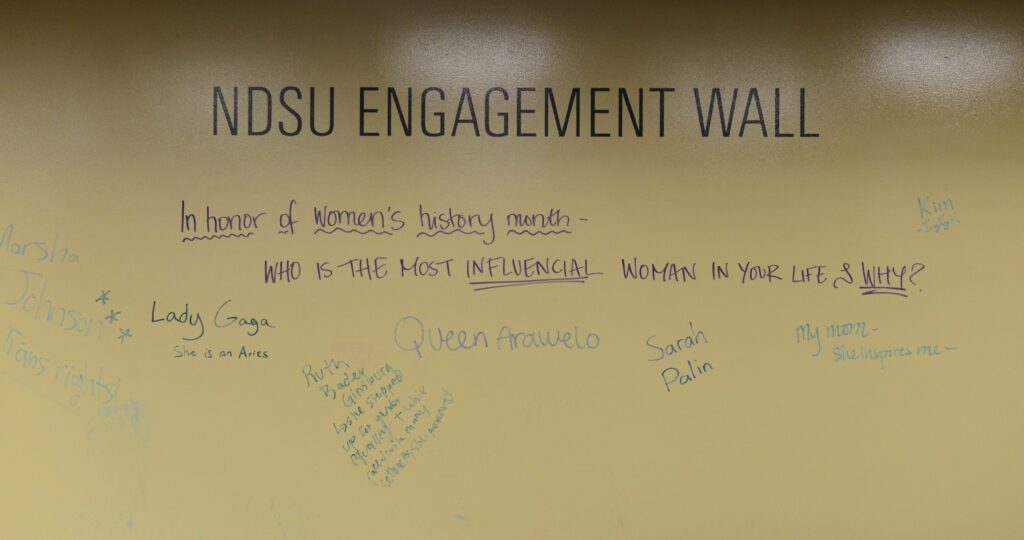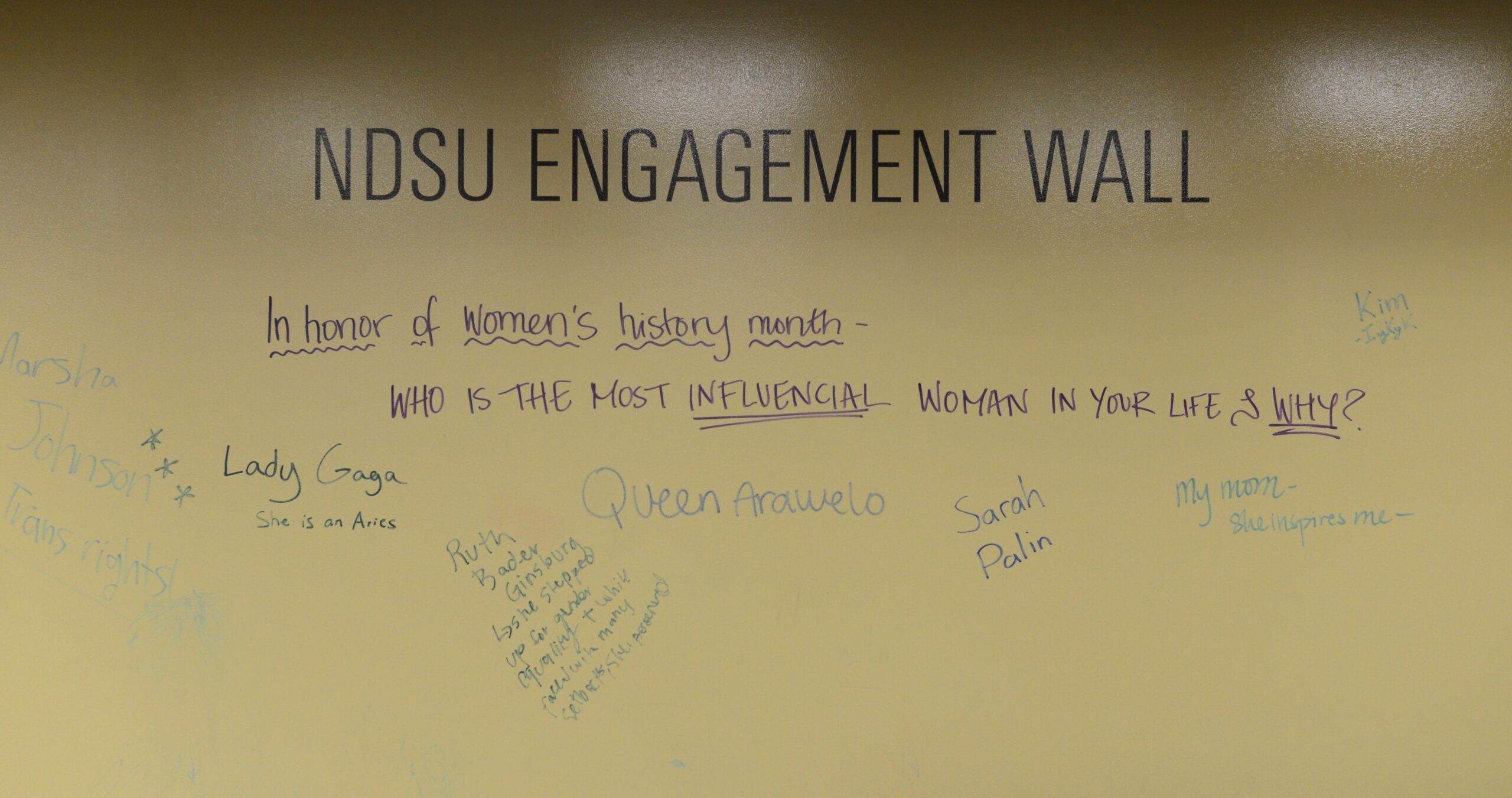Gender inequality remains a prevalent issue

In the Memorial Union, there’s a place where the NDSU community can highlight influential women.
International Women’s Day, a global holiday celebrating the achievements of women and encouraging an end to gender inequality was celebrated this past Monday, March 8th. Among the commemoration of the many powerful and amazing women in this world, there was some critical backlash to the holiday, often attempting to remain hidden behind jokes and biting comments.
News stories and social media posts relating to the holiday were filled with comment sections asking, “Why isn’t there an International Men’s Day,” or making light of the day by arguing gender inequality doesn’t exist and anyone who argues it does is victimizing.
While many people can readily acknowledge that pretty much every day of the year is already ‘International Men’s Day’ (hence the lack of need for the holiday) and that calling out inequality is not about victimization and weakness—in fact, such actions are often quite brave—it’s concerning that so many people seemed to share negative sentiments, and even more concerning are the number of people who decided to say nothing at all.
The fact that arguments exist for why we shouldn’t have an International Women’s Day is evidence enough that such a holiday is still needed. If we can’t feel secure in celebrating and striving to empower all women everywhere, then we still have work to do.
Looking toward economic inequality, the United Nation’s International Labour Organization found that across the globe, men tend to earn more than women. More than this, women are consistently underrepresented in leadership positions within companies, but over-represented in low-paying jobs.
More than just being given unequal access to a fair wage and access to certain positions, in many countries women are much less likely to own land or control assets than are men. This, coupled with the fact that women are given less influence over decisions in their own household in many places, paints a concerning picture of women’s agency in many parts of the world.
Without money, assets or the power of choice, women are often stripped of many of the freedoms readily given to men. Add to economic disadvantages the fact that women have less access to higher education, less access to health care, are at more of a risk to safety concerns and have less political access and the gender disparities around our world become readily apparent.
You don’t need an intense background in international studies to recognize that gender inequality exists, because it is happening right here, in our own country, in our own city, every day.
Many people have and will criticize the recognition of gender issues within the United States. Looking at the global issues of intense economic, educational, health and social gender inequality, they will argue that America is a beacon of equality in comparison.
Often, people will look at the worst cases across the globe—honor killings, female circumcision, lack of access to political agency, bodily autonomy and legal protections—and argue the U.S. is doing fine.
Any form of inequality, and especially these often pointed to as examples, are appalling and should absolutely be addressed, but it would be ignorant to look at these examples and tell ourselves that anything better than the absolute worst is acceptable.
We can simultaneously recognize that other places in the world have gender inequality without disparaging the fact that gender inequality is pervasive in our own society as well.
Looking only at the U.S., the Economic Policy Institute released findings that found that women have been much more negatively impacted by the coronavirus pandemic economically than men.
Service occupations, where women are twice as likely as men to be employed, have been the hardest hit by lay-offs. With this, frontline jobs which are often deemed ‘essential’ and require employees to risk their health, are also heavily staffed by women.
Bureau and Labor Statistics data reveals how, despite having the same unemployment rate in March of 2020, women’s unemployment went up roughly 12 percent by April, while men’s only went up 9 percent. The unemployment rate did settle between women and men by December, the income loss to women was much more significant.
Looking at the recent argument on a minimum wage increase, you could also see this as a gendered issue. Of those citizens making minimum wage, women make up 63 percent of the total. So the fact that the wage has stayed stagnant since 2009 is a problem that overwhelmingly hurts women.
The wage gap currently has women making 81 cents for every dollar a man earns, and that gap grows even larger if you are a Black or Hispanic woman.
While economic differences are important, especially in this country where income often relates to the level of healthcare and education an individual and their dependents have access to, there are social and political differences as well. The American Journal of Sociology found that attitudes towards societal roles for men and women haven’t really changed in the last 30 or so years.
Despite public and media attitudes that we are constantly progressing, most people in the U.S. hold an “egalitarian but traditional” gender framework that supports traditional gender roles so long as they don’t appear sexist or discriminatory.
Meaning, most people still accept, normalize and prefer men to be hegemonically masculine breadwinners and for women to be homemakers, caretakers and mothers, so long as these roles don’t look too sexist (regardless if they really are).
In American politics, only 18.3 percent of congressional seats and 23 percent of statewide elective officers are held by women, according to data from the Center for American Women and Politics. This is actually a decrease from 2001 when women held 27.6 percent of statewide elective positions.
We do have our first female and POC Vice President, but it can be hard to celebrate that it took us 243 years and 48 male Vice Presidents to finally get a woman in that position. In a country that is more than 50 percent female, it would make sense for our government to be at least marginally representative of that.
The U.S. also has issues of widespread sexual assault against women. While sexual assaults certainly can and do harm men as well, sexual assault is often seen as ‘women’s issue’ because women are more likely to be harmed by sexual assault; instead of it being seen as a ‘men’s issue,’ since they are by far the most likely to perpetrate a sexual assault.
One of the most pressing issues in the U.S. right now is the rights of transgender women and men. Transgender women are often forced to ‘prove’ their womanhood.
Bathroom bills, meant to police which women can and can’t use the restroom of their choice, are humiliating and misleading. Transgender women are at a high risk of being assaulted by cisgender people for using the restroom, while an attack by a transgender person in a restroom is virtually unheard of.
Lack of medical care, discriminatory laws, inaccurate media representation and general social stigma are subjects transgender women have to learn to navigate just to survive in our country. A woman shouldn’t have to prove anything to be accepted and given access to basic human rights, a person shouldn’t have to prove anything to be treated with respect and decency.
All of these inequalities present in the U.S.—economic, political, social—are only heightened for women of color. Many individuals who argue against the need for an international day for the celebration of women are White, and in fact, a fair portion are women. The experiences of women of color in this country are varied but often are influenced by inequality based on race that white women do not experience.
Recognizing how not only gender affects inequality, but race, sexuality, ethnicity, cultural background, age, ability and every other kind of identity is essential. Women of color have historically been forgotten and ignored in many international and national campaigns for gender equality, and that’s a mistake that needs to be answered for.
The point ultimately is to say that while improvements have been made in the fight for gender equality, many places around the world, including our own country, still exemplify injustice.
Calling out inequality is not about ‘victimizing’ women; in fact, it has the opposite effect of empowering women by giving them a voice for their lived experiences and legitimacy to help make the economic, political and social moves necessary to work towards greater equality.
So happy International Women’s Day, to every woman, of every background, everywhere. Here’s to the work we still have yet to do.
